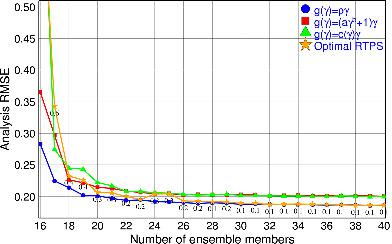当前位置:
X-MOL 学术
›
Q. J. R. Meteorol. Soc.
›
论文详情
Our official English website, www.x-mol.net, welcomes your
feedback! (Note: you will need to create a separate account there.)
Analysis and design of covariance inflation methods using inflation functions. Part 2: adaptive inflation
Quarterly Journal of the Royal Meteorological Society ( IF 3.0 ) Pub Date : 2021-03-23 , DOI: 10.1002/qj.4029 Le Duc 1 , Kazuo Saito 2 , Daisuke Hotta 3
Quarterly Journal of the Royal Meteorological Society ( IF 3.0 ) Pub Date : 2021-03-23 , DOI: 10.1002/qj.4029 Le Duc 1 , Kazuo Saito 2 , Daisuke Hotta 3
Affiliation

|
Part 1 of this study shows the existence of a unifying theory that encompasses all exiting covariance inflation (CI) methods under a framework of inflation functions operating on the eigenvalues of the ensemble transform matrix. Given a vast space of potential inflation functions, a natural question is how to choose the optimal one. This part 2 shows how adaptive inflation can be implemented in the context of inflation functions to estimate inflation functions on-the-fly from observations. Estimation of prior inflation functions (PIF) is equivalent to estimation of background error covariances G in observation space. However, the conventional CI methods confront a difficult problem of how to convert G back to model space to calculate analysis increments and perturbations, which is possible in very limited cases such as multiplicative inflation. The solution here is to exploit the equivalence between PIFs and inflation functions to transplant the estimated PIF into its equivalent inflation function. Analysis increments and perturbations can be calculated using this intermediate inflation function. Maximum likelihood (ML) estimations of three families of PIFs with two data assimilation systems show that this approach works well and that the adaptive methods can even beat a well-tuned CI method. Estimation of the inflation functions that do not have equivalent PIFs is more difficult since we lack a theoretical guidance, such as Bayesian inference as in the case of PIFs. Those inflation functions are proposed to be estimated from posterior innovation statistics. There are two supporting facts for this estimation: (a) ML estimation of nonparametric PIFs leads back to the prior innovation statistics, and (b) posterior innovation statistics is an effective diagnostic tool for assessing performance of inflation functions. It is interesting to find that ML estimates of inflation functions yield analyses and forecasts better than ML estimates of PIFs.
中文翻译:

使用膨胀函数分析和设计协方差膨胀方法。第 2 部分:适应性通货膨胀
本研究的第 1 部分展示了一个统一理论的存在,该理论包含在膨胀函数框架下对集成变换矩阵的特征值进行操作的所有现有协方差膨胀 (CI) 方法。鉴于潜在的膨胀函数空间巨大,一个自然的问题是如何选择最优函数。第 2 部分展示了如何在通货膨胀函数的背景下实施自适应通货膨胀,以根据观察动态估计通货膨胀函数。先验膨胀函数 (PIF) 的估计等效于观测空间中背景误差协方差G 的估计。然而,传统的 CI 方法面临一个难题,即如何将G返回模型空间以计算分析增量和扰动,这在非常有限的情况下是可能的,例如乘法膨胀。这里的解决方案是利用 PIF 和膨胀函数之间的等价性,将估计的 PIF 移植到其等效的膨胀函数中。可以使用此中间膨胀函数计算分析增量和扰动。具有两个数据同化系统的三个 PIF 族的最大似然 (ML) 估计表明这种方法运行良好,并且自适应方法甚至可以击败经过良好调整的 CI 方法。没有等效 PIF 的膨胀函数的估计更加困难,因为我们缺乏理论指导,例如在 PIF 的情况下的贝叶斯推理。建议从后验创新统计数据中估计这些通货膨胀函数。这种估计有两个支持事实:(a) 非参数 PIF 的 ML 估计可以追溯到先前的创新统计数据,以及 (b) 后验创新统计数据是评估通货膨胀函数性能的有效诊断工具。有趣的是发现通货膨胀函数的 ML 估计比 PIF 的 ML 估计产生更好的分析和预测。
更新日期:2021-03-23
中文翻译:

使用膨胀函数分析和设计协方差膨胀方法。第 2 部分:适应性通货膨胀
本研究的第 1 部分展示了一个统一理论的存在,该理论包含在膨胀函数框架下对集成变换矩阵的特征值进行操作的所有现有协方差膨胀 (CI) 方法。鉴于潜在的膨胀函数空间巨大,一个自然的问题是如何选择最优函数。第 2 部分展示了如何在通货膨胀函数的背景下实施自适应通货膨胀,以根据观察动态估计通货膨胀函数。先验膨胀函数 (PIF) 的估计等效于观测空间中背景误差协方差G 的估计。然而,传统的 CI 方法面临一个难题,即如何将G返回模型空间以计算分析增量和扰动,这在非常有限的情况下是可能的,例如乘法膨胀。这里的解决方案是利用 PIF 和膨胀函数之间的等价性,将估计的 PIF 移植到其等效的膨胀函数中。可以使用此中间膨胀函数计算分析增量和扰动。具有两个数据同化系统的三个 PIF 族的最大似然 (ML) 估计表明这种方法运行良好,并且自适应方法甚至可以击败经过良好调整的 CI 方法。没有等效 PIF 的膨胀函数的估计更加困难,因为我们缺乏理论指导,例如在 PIF 的情况下的贝叶斯推理。建议从后验创新统计数据中估计这些通货膨胀函数。这种估计有两个支持事实:(a) 非参数 PIF 的 ML 估计可以追溯到先前的创新统计数据,以及 (b) 后验创新统计数据是评估通货膨胀函数性能的有效诊断工具。有趣的是发现通货膨胀函数的 ML 估计比 PIF 的 ML 估计产生更好的分析和预测。











































 京公网安备 11010802027423号
京公网安备 11010802027423号